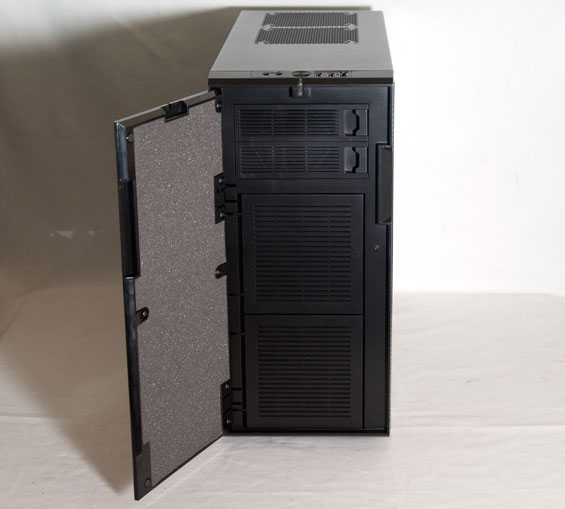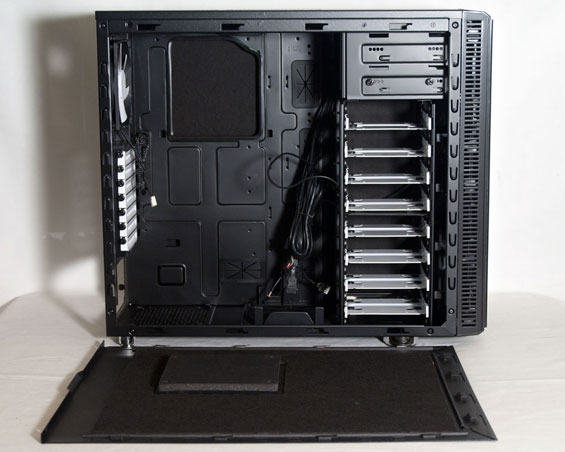Fractal Design Define R3: A Fan Favorite Keeps the Noise Down
by Dustin Sklavos on November 11, 2011 1:22 AM EST- Posted in
- Cases/Cooling/PSUs
- mid-tower
- Fractal Design
In and Around the Fractal Design Define R3
If you read our review of the Fractal Design Arc Midi, the Define R3's interior is going to seem pretty familiar. That's not necessarily a bad thing; Fractal Design brings a lot of smart ideas to the table with the two enclosures, and the R3 in particular seems to really maximize its internal real estate compared to some of the competition. It's not a big case, but there's a lot to it.

Before we get to that, though, the basics: the R3 uses a foam-padded door on the front to keep the noise in, but unlike Antec's older P180 series designs, Fractal Design wisely places the power button and I/O ports at the top of the enclosure, above the door. The result is a door that becomes less of a nuisance and more functional. When you open it, you'll find the two 120mm fan mounts (one of which is occupied) as well as just two 5.25" drive bays. Some users might chafe at the notion of being stuck with just two bays, but I honestly prefer it for most enclosures. Surrounding the door on the outside is a ventilated region that allows the intake fan to pull in air from the sides; this is an improvement over NZXT's H2, whose door threatens to completely suffocate the intakes, but it feels minimal compared to the intakes in Antec's P180 series.
The sides and bottom of the enclosure are pretty much what you've come to expect, with two fan mounts on the top, one on the side, and one on the bottom, but the difference here is that every mount but the bottom one is basically sealed off with removable acoustic foam panels. This honestly feels like such a good idea that I'm baffled as to why it's not more common, because it basically allows the R3 to succeed either as a quiet case or as a performance case (provided you add additional fans), as well as offering several points in between. I love it, and I wish more enclosure designers would implement something like this. Moving around to the back of the enclosure we see Fractal Design's traditional set of white expansion slot covers and the white exhaust fan, but otherwise nothing particularly noteworthy.

When you pop the R3 open, though, you'll see an interior that's largely well designed and really maximizes the available space. A friend of mine is in the market for a new case, and when I showed her the R3 she actually called the eight drive trays "extravagant." That may very well be, but they're an appreciated amount of expansion (even if a touch excessive), and the lateral mounting allows for easy cable routing to behind the motherboard tray. Fractal Design also includes the usual grommet-lined holes for cable routing, but they're a touch smaller in the R3. As for expansion clearance, odds are you're not going to be fitting an AMD Radeon HD 6990 or ASUS Mars II in here, but if you can afford either of those, why are you buying a $100 case? I found the clearance for power supplies, expansion cards, and CPU cooling to be just right.
Fractal Design has also padded both side panels, a much appreciated gesture keeping in line with the R3's ambitions as a silent chassis.
Ultimately I'm a fan of the R3's aesthetics (particularly the blue LED at the top center of the case that goes up and around the power button), and it's been my experience that a lot of you also like these generally sleek, minimalistic designs. The good news I have for you is that you've spoken and it seems the vendors are listening, given what Fractal Design is doing, along with BitFenix and some others. Even a recent conversation with Antec about the upcoming P280 suggests you're being heard loud and clear.
















83 Comments
View All Comments
ven - Friday, November 11, 2011 - link
If anybody wants ever more silent PC take a look at the CM silencio 550.Great look i was stunned by the mirror finish front panel of that case(yes of course that means more prone to scratches and finger prints).Only thing it lacks the R3 is by the fan count but that is not the problem for those who need a Ultimate silent PC if anybody decided there preference is silence then silencio will be a great option.And for those who has trade-of between silence and performance go for the R3.They both have same price range(95-110$)
piroroadkill - Friday, November 11, 2011 - link
Good call. Looks nice, and has a removable cage too, if you want a massive card.ven - Friday, November 11, 2011 - link
Yes, that's a nice option i like the silencio especially for that.And also silhouetted holes at rear of the case for water cooling making this case a solution for small,silent gaming ring.Dustin, check this case immediately it's a great competitor for R3.
For more information:
http://www.guru3d.com/article/cooler-master-silenc...
Peskarik - Saturday, November 12, 2011 - link
I looked at this case when I was choosing, also at Thermaltake Element S.Silencio does not have enough cooling expansion capacity.
ven - Friday, November 11, 2011 - link
sorry not front panel the front door i meant to refer.geniekid - Friday, November 11, 2011 - link
SPCR.com gives the nod to the R3 and the H2 over the Silencio, but it does note that the Silencio is cheaper than both (about $70 vs $100).http://www.silentpcreview.com/article1210-page8.ht...
I certainly wouldn't mind AT reviewing it though :)
Dustin Sklavos - Friday, November 11, 2011 - link
Cooler Master stuff is a bit harder to get in and honestly I wasn't impressed with the Silencio 550 when iBuyPower used it for their workstation, since it utterly failed to dampen hard drive noise.Peskarik - Saturday, November 12, 2011 - link
What about Thermaltake Element S? Especially the version with side fan?XiZeL - Friday, November 11, 2011 - link
Would a corsair H100 Fit well in this and would perform well?thinking about this case with a i5.2500k with reference 6950(blowing air out)
slacr - Friday, November 11, 2011 - link
Fit, sortof.Fit well, no. I originally wanted to place a 2*120mm radiator in the roof of my case, but the top cutouts are 2*140 with fan mount holes for 120 in the middle of them. This results in a spacing between the two 120mm mounts being too far apart for standard radiator hole spacing. Trying to use a 2*140 radiator will place it too close to the motherboard. So in order to fit it properly in this case you have to make modifications.
They did adress the watercooling/H100 issue with a different case, the Arc, see link here: http://www.fractal-design.com/?view=product&pr...
I don't have any experience with that case though.